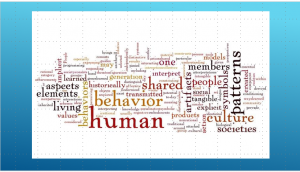Today marks my third year at Temple University Libraries – a good time for reflection on how the organization has developed a culture of assessment. One thing I have learned. An assessment librarian does not a culture of assessment make. The practice of continuously asking questions of ourselves, our value to the institution, considering the metrics and research methods appropriate to those questions and values – it takes time to embed that practice into our work.
When I interviewed for this position, I began my presentation to the staff with this slide, composed of a word cloud based on definitions of the word culture:
I asked, “What would a culture of assessment look like?”, suggesting that it meant having a shared value system among staff about the benefits of assessment practice in how we do our work – that practice then becomes a pattern of behavior and is incorporated into the thinking about our work and improving our service to users. I think this concept still holds true.
Organizational Development
A culture of assessment must be more than the “doing” of assessment. It requires us to analyze, reflect on, and act upon our findings. For instance,
- We must consider changes based on our focus group data, our surveys, our usability testing, our interviews with faculty.
- We must then share our findings with staff and external audiences, and make explicit the changes we are making (or not) based on research findings.
This feedback loop is essential, and is continuous.
How do we empower our staff with the skills to do that research? It’s easy to gather data, but we need methods that insure the data and their interpretation are sound. This constitutes the organizational development aspect of building culture – in which assessment is not limited to a few but all staff are empowered with the skills to participate.
Strategic Planning
In 2014 here at Temple Libraries/Press we established an annual strategic action planning process that included an expectation for assessment with each objective. As new initiatives and ongoing ones are considered, we ask ourselves:
What does success look like? Ideally, that answer will be more than a count, but a measure of impact or growing reach into our communities.
- Is our instruction program effective? How do we know that our students are incorporating critical thinking skills into their research and coursework?
- Are we reaching new audiences? How are those communities engaged in our programs and how might they support the library in other ways?
These measures of impact (and return on investment) are much harder to determine. Gathering that evidence requires a commitment to planning and sustained support for a robust technical infrastructure for data collection, analysis and access.
Finally, a culture of assessment requires that these questions of effectiveness, self-examination and advocacy are systematically integrated into the fiber of the organization.
- Are we reviewing our operations in light of our values for transparency, developing staff and collaborating across departments?
- At budget time, do we review our spending and our work flow efficiencies as we justify new funding requests?
- When a position goes vacant, do we reconsider that position within the organizational direction and new priorities?
In my three years I’ve learned (and as Lakos and Phipps discussed 13 years ago*) that organizational development, strategic planning and assessment serve together to balance that three-legged stool, and only with alignment in these areas will the stool stand firmly on the ground. Equally essential are the staff, the participants in this culture, that bring assessment alive as a true shared value for the library.
Three years in and we are definitely on the ground.
*Lakos and Phipps, Creating a Culture of Assessment: A Catalyst for Organizational Change (portal: Libraries and the Academic, Volume 4, Number 3).

